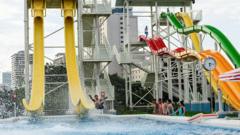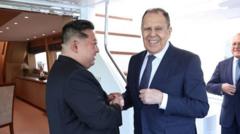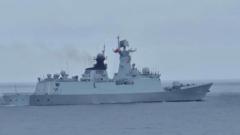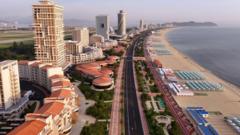Kim Jong Un's leadership faces challenges after a failed warship launch led to arrests and criticism, but the successful refloating of the vessel signals continued efforts to enhance North Korea's military image.
North Korea Successfully Refloats Warship After Launch Debacle
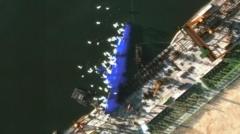
North Korea Successfully Refloats Warship After Launch Debacle
Following a critical incident during its launch, North Korea has managed to refloat a destroyer, demonstrating resilience amid mounting scrutiny.
North Korea has reportedly managed to refloat a destroyer that had previously capsized during a launch attempt, following significant criticism from its leader, Kim Jong Un. The state-run news agency KCNA announced on Friday that the 5,000-tonne warship had "safely entered the water vertically" and is now secured at a pier. It is anticipated that repairs will be completed in time for a key governmental meeting led by Kim, involving senior officials of the ruling party.
Images shared by specialized news sites, 38 North and NK News, indicated that the warship was upright at the pier and, shortly thereafter, seen "floating in the harbour." The refloating operation, which took place on Thursday, entailed a manual process; workers were observed using tethers and barrage balloons to stabilize the ship, with some balloons still visible attached to the vessel.
Previously, Kim had witnessed the mishap during a failed launch two weeks ago and condemned it as a "criminal act" that undermined the nation's dignity and pride, attributing the failure to "absolute carelessness" and "irresponsibility." The incident led to the arrest of at least four officials, including Ri Hyong-son, who holds a significant position within the Workers' Party's Munitions Industry Department, which oversees military development.
While the specific consequences for these officials remain uncertain, North Korea’s history suggests that severe punishments including forced labor or execution could be possible. Analysts interpret Kim’s rigorous response to the initial failure as indicative of his commitment to advancing military capabilities, reinforcing the regime's portrayal as a burgeoning military power.
Michael Madden, an expert on North Korea from the Stimson Center, emphasized that Kim’s stringent reaction reflects the high priority placed on military modernization, especially following the recent unveiling of another warship labeled a "breakthrough" in enhancing North Korea’s naval strength, slated for deployment next year.
Images shared by specialized news sites, 38 North and NK News, indicated that the warship was upright at the pier and, shortly thereafter, seen "floating in the harbour." The refloating operation, which took place on Thursday, entailed a manual process; workers were observed using tethers and barrage balloons to stabilize the ship, with some balloons still visible attached to the vessel.
Previously, Kim had witnessed the mishap during a failed launch two weeks ago and condemned it as a "criminal act" that undermined the nation's dignity and pride, attributing the failure to "absolute carelessness" and "irresponsibility." The incident led to the arrest of at least four officials, including Ri Hyong-son, who holds a significant position within the Workers' Party's Munitions Industry Department, which oversees military development.
While the specific consequences for these officials remain uncertain, North Korea’s history suggests that severe punishments including forced labor or execution could be possible. Analysts interpret Kim’s rigorous response to the initial failure as indicative of his commitment to advancing military capabilities, reinforcing the regime's portrayal as a burgeoning military power.
Michael Madden, an expert on North Korea from the Stimson Center, emphasized that Kim’s stringent reaction reflects the high priority placed on military modernization, especially following the recent unveiling of another warship labeled a "breakthrough" in enhancing North Korea’s naval strength, slated for deployment next year.

